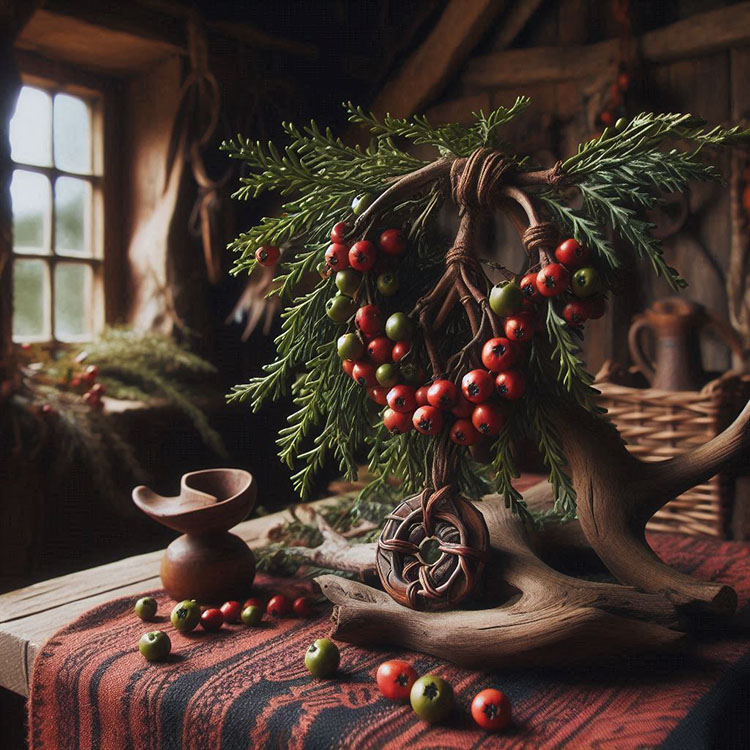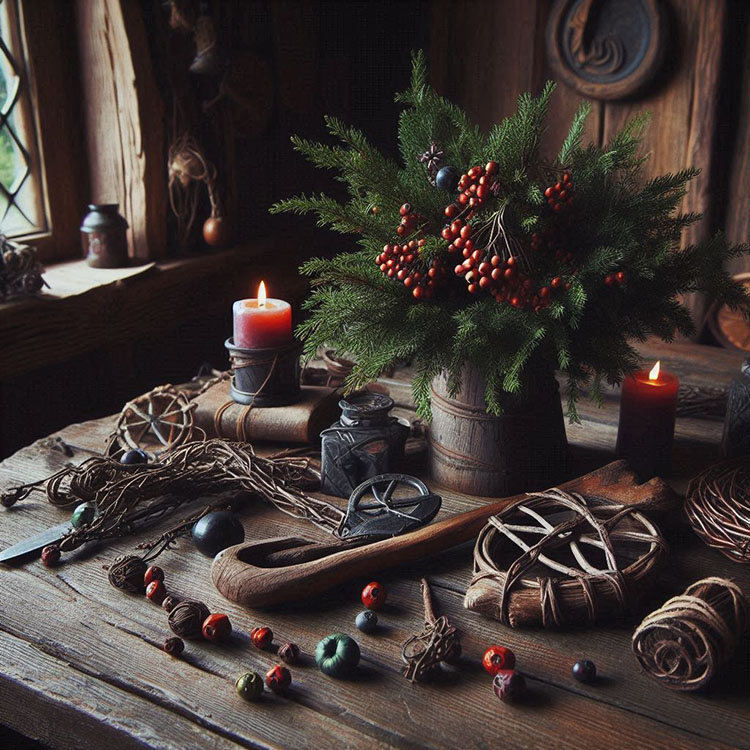
In the traditional culture of the Western Slavs, the yew tree was used to ward off evil, bad luck, disease, witches, and just about anything else unpleasant that might try to creep into people’s lives. Its symbolic significance likely stemmed from its wood — exceptionally strong, and in some cases, quite literally used in place of iron. And any tree that can stand in for iron deserves a little reverence. Possibly also a caution sign.
In Serbian belief, the yew was no ordinary tree — it was the world axis. Its crown brushed the sky, its roots wound deep into the underworld, and at its base was the source of water and the gateway to the lower realm. Convenient, if you happened to need both refreshment and metaphysical insight. It was said to grow only in pure places and served as a meeting point for vily — the elusive and temperamental Slavic nature spirits.
As a sacred tree, the yew was used to treat “holy diseases” — illnesses like epilepsy and tuberculosis, which were often thought to be caused by spiritual forces rather than germs.
In Bosnia, the yew was believed to be the very tree on which Christ was crucified, granting it instant sanctity and a prominent place in devotional practices. Small pieces were kept near icons for protection, and on Easter, if no blessed food was available, people would chew the leaves of consecrated yew — spiritually nourishing, if not particularly tasty.

In some parts of the Slavic world and Sweden, yew wood was carved into amulets of various shapes: crosses, hearts, axes, and other handy symbols of protection. Crosses made of yew were worn under shirts; small chips were braided into the manes of horses, fastened to cows’ horns, or tied to the bells of sheep. Tiny fragments were sewn into children’s collars and women’s belts to protect against the evil eye and demons — especially those fond of haunting childbirth. Yew even found its way into cradles and children’s beds to safeguard health, and was tucked into swaddling cloths during nursing. On the eve of Maslenitsa — an Eastern Slavic folk holiday — when witches were believed to be especially active, yew crosses were placed in cradles for extra protection.
In Montenegro, it was believed that a yoke made of yew could trap and destroy a witch, neutralize evil influences, break curses, and confuse demons — which is impressive for a tree.
Yew spoons were said to preserve happiness. Sheaths for knives and other weapons made from yew ensured they remained effective. Chips of yew were kept in wallets to prevent money from mysteriously vanishing, and livestock were driven with yew branches to promote fertility. On St. George’s Day, homes and fields were decorated with yew to guard against hail, which has never had the best reputation.
Among the Hutsuls, every household kept at least a little yew — a piece of wood, a root, or even just some bark. It was regarded as a magical catch-all, protecting both people and animals from illness, thunder, and misfortune.
Consecrated yew wood was considered especially powerful. In Poland, on the eve of Epiphany, people would bless pieces of yew and fumigate their livestock with the smoke — a kind of spiritual dry cleaning. This ritual was meant to protect against disease, rabies, evil spirits, and overly aggressive stray dogs.
In Montenegro, there was a ritual known as “guarding the yew.” A piece of yew was cut and taken to a yard or pasture, where a virgin (gender-flexible, but required to be innocent) would light a fire nearby. The wood was placed close to the fire — not in it — and watched all night, with the flame tended and the tree vigilantly guarded. At dawn, a gun was fired, and the guardian declared the ritual complete. That piece of wood, now considered infused with power, was then carved into protective amulets. What happened if someone fell asleep during the watch isn’t recorded, but one imagines it led to a certain amount of village gossip.
Despite its sacred and protective status, the yew was also feared. It is, after all, highly toxic. Western European herbals that made their way to Slavic lands warned that even the yew’s shadow was dangerous. Sitting beneath it too long might steal your dreams, poison your sleep, or kill you outright. In Kosovo, it was believed that anyone who burned yew would die within the year — a superstition observed faithfully, just in case.
These darker associations may explain the yew’s connection to funerary rituals. In The Tale of Igor’s Campaign — a twelfth-century Russian epic poem — Prince Sviatoslav dreams of a yew bed. Not a cozy place for a nap, but a symbolic coffin, part of a broader tapestry of ominous visions.

In broader European tradition, the yew’s reputation as a tree of death and doom was well-earned — but so was its status as a tree of eternal life.
Among the Druids, yew was regarded as one of the holiest trees and was planted in their most sacred places. Legends abound, many linking the tree with fertility rites and the granting of wishes — a generous streak for a tree often associated with death.
In Christian times, yews were commonly planted in churchyards. Some said it was because they symbolized immortality — evergreen and extraordinarily long-lived — while others believed it was a practical move to protect valuable wood from being cut down. There’s also the theory that yew helped preserve corpses: a 19th-century account tells of bodies bathed in yew-leaf infusions to keep them from rotting for weeks.
In the English Fens, people believed witches lived under the drooping branches of ancient yews. One did well not to linger beneath them — unless one wished to become part of the scenery.
Dreams of yew trees were said to foretell the death of an old person, and dowsing with yew branches could supposedly lead one to lost objects — assuming those objects hadn’t grown legs and walked away.
Yew wood was famously used to make the longbows of English archers, and some believe its Latin name, Taxus, comes from the Greek taxon, meaning “bow.” From that, we may also get the word “toxic.” Which, all things considered, makes perfect sense.
Tags:

Leave a Reply